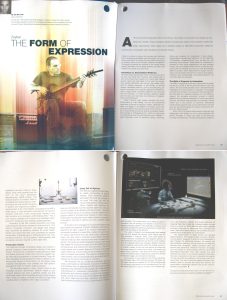Following our announcement in IDSA’s Innovation Quarterly Design Journal, As from today our 3D CAD production files will be available for non commercial use. The transformation to digital formats has changed entire industries. This change enables musicians, film makers and graphic designers to become more independent. It also changed the relationship between the creators and their production platforms. As the resources and platforms became more accessible, creative disciplines grow and became decentralized. Hardware innovation and design are in the middle of a similar change. With the increasing usage of these decentralized fabrication sites, CAD softwares and open hardware we envision the beginning of a new creative biosphere.

Knowledge technologies
The information revolution released the bottlenecks of distribution. The second decade of the 21st century will be characterized by efforts to release the bottlenecks of production. Today in almost every creative discipline like music, photography or video editing you can rent professional equipment or a studio to produce a project. The transformation of these disciplines to digital format has made them even more accessible and collaborative. Scanners, printers, samplers and editing softwares are just some of the tools that enable us to read, write and edit information, whether it is music, text, images or cad files they are all qualified as knowledge technologies. In our view hardware innovation and design shouldn’t be different. Local hardware fabrication services are becoming more common, similar to local printing services for photos and graphic design. 3D fabrications machines and services are already available on the web [Ponoko] [Shapeways] and are expected to become common as domestic paper printers are today.
Domestic 3D printer’s potential
The domestic fax/printers were once considered as new pipe lines to distribute printed media content directly to the readers. Obviously it didn’t come true, it was the same content, only on a new manufacturing platform. For the passive consumers it didn’t make a difference. We mostly use domestic printers to print (create) our own original content or when we need a hardcopy and can’t get it elsewhere. Passive consumption of content (objects) doesn’t provide the incentives to use these new machines.
3d printer’s potential isn’t in fabricating existing available objects by passive consumers. Their most powerful feature is providing special needs that aren’t being recognize by mass production manufacturers.
Save
Save
Save
Save
Save
Save
Save
Save
Save
Save
Save
Open Language
The increasing usage and development of knowledge technologies is based on the principal of collaborative and gratifying process. Common language is the key for collaboration and the system for distributing knowledge. Without common language, duplicating hardware innovation remains a fragmented process. The common denominator of open sourced software and hardware is the concept of language. A common recognizable system of elements, different attributions between the elements composes different meaning and functions. Zoybar can be considered as a hardware version that might be similar to the Firefox browser concept with hardware add-ons and user-made applications. Both are opened, customizable platforms able to receive different applications that add to their user experience.
Zoybar is a new form of expression, a language that provides knowledge and information for the creation of music instruments. Zoybar is an open sourced language. Users can improve, create and add more components on a collaborative platform.
Open hardware architecture translates as open modular systems. Zoybar is not a specific instrument. We provide physical and virtual platforms as creation tools for developing new music instruments. We believe that open cooperation is the key to maximize the potential of these resources and platforms. We’ve done most of the heavy lifting. Our vision is that this release will inspire independent users to innovate and share new add-ons and sound effects manipulation features with minimum restriction as possible.